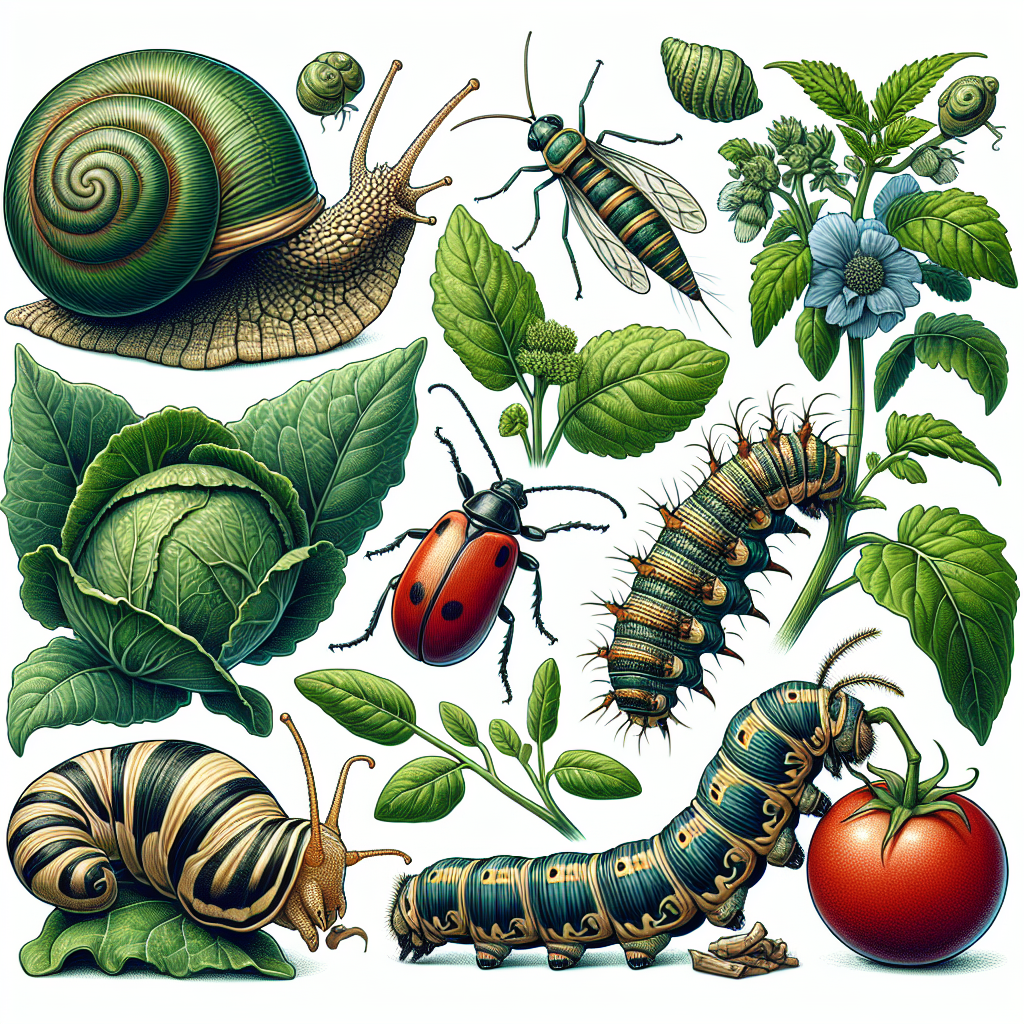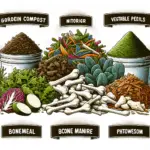Understanding Garden Pests
Garden pests can be a nuisance for any gardener, causing damage to plants and frustrating the efforts put into maintaining a beautiful garden. Understanding the types of pests that may invade your garden and learning how to control them is essential for a thriving garden.
The Common Culprits
- Aphids: These tiny insects feed on plant juices and can cause leaves to curl and distort.
- Slugs and Snails: These creatures tend to feast on young plants and can quickly decimate a garden.
- Caterpillars: The larvae of butterflies and moths, caterpillars can munch on leaves and flowers.
- Spider Mites: These arachnids are known for creating fine webbing on plants and sucking nutrients from them.
Signs of Pest Infestation
Recognizing the early signs of pest infestation can help you take action before significant damage occurs. Look for:
- Chewed or damaged leaves
- Holes in fruits or vegetables
- Yellowing or wilting of plants
- Unusual spots or markings on leaves
Organic Pest Control Methods
Using organic pest control methods is a safe and environmentally friendly way to manage pests in your garden. Consider these approaches:
- Introduce beneficial insects that prey on garden pests.
- Use neem oil spray to deter common pests.
- Plant companion species that naturally repel pests.
Preventing Pest Infestations
“An ounce of prevention is worth a pound of cure.”
Implementing preventive measures can save you time and effort in dealing with pest infestations:
- Keep your garden clean and free of debris where pests can hide.
- Mulch around plants to discourage pests and retain moisture.
- Rotate crops to prevent the buildup of specific pests in one area.
Common Garden Pests and Their Damage
Garden pests can wreak havoc on your carefully tended plants, causing damage that ranges from unsightly blemishes to complete destruction. Identifying these common pests and understanding the type of damage they cause is crucial for effective pest control in your home garden.
1. Aphids
Aphids are tiny, pear-shaped insects that feed on plant sap. Their damage includes:
- Stunted Growth: Aphids can cause plants to become stunted and distorted.
- Yellowing Leaves: Leaves may turn yellow and eventually drop off.
- Honeydew: Sticky residue left behind by aphids can attract mold.
- Irregular Holes: Leaves with irregular holes are a sign of their presence.
- Slime Trails: Shiny trails on plants or soil indicate slug or snail activity.
- Chewed Leaves: Ragged edges or holes in leaves are a common sign of caterpillar damage.
- Frass: Caterpillar droppings, known as frass, may be present near feeding sites.
- Yellow Speckling: Leaves may develop yellow spots or a mottled appearance.
- Fine Webbing: Spider mites often leave fine webbing on the plant’s surface.
- Plants Toppled Over: Plants may appear to have been cut at the base and be lying on the ground.
- Seedlings Damaged: Newly emerged seedlings are particularly vulnerable to cutworms.
- Chewed or Damaged Leaves: Irregular holes, ragged edges, or skeletonized leaves are common signs of insect feeding.
- Wilting or Discolored Plants: Sudden wilting or unexplained yellowing of plant parts can signal pest infestation.
- Visible Pests: Spotting pests like aphids, caterpillars, or beetles on your plants is a clear sign of infestation.
- Stunted Growth: If your plants are not growing as expected or are smaller than usual, pests may be affecting their development.
- Decreased Yield: A sudden drop in harvest quantity may indicate pest damage affecting the plant’s ability to produce.
- Webs or Egg Masses: Spider mites and certain caterpillars leave silk webs or egg masses on plants.
- Fecal Droppings: Look for small droppings or trails of excrement left behind by pests.
- Biological control: Introducing natural predators or parasites to manage pest populations organically.
- Cultural practices: Implementing techniques such as crop rotation and proper plant spacing to deter pests.
- Mechanical control: Using physical barriers like row covers or traps to limit pest access to plants.
- Chemical control: Utilizing pesticides as a last resort, following all safety precautions and guidelines.
- Leaf damage: Holes, discoloration, or wilting leaves can signify pest feeding.
- Insect sightings: Identifying pests such as aphids, caterpillars, or beetles on plants.
- Weakened plants: Stunted growth, drooping foliage, or lack of flowering may indicate pest infestation.
- Inspect your plants regularly to catch pest issues early on.
- Look for signs such as holes in leaves, chewed stems, or discoloration.
- Act promptly upon discovering any pests to prevent further infestation.
- Ensure proper drainage to prevent waterlogging.
- Use organic matter like compost or mulch to improve soil fertility.
- Rotate crops to reduce pest build-up in the soil.
- Planting diverse vegetation to encourage predator habitat.
- Installing bird feeders to invite insect-eating birds.
- Row covers can shield plants from flying insects.
- Copper tape can deter snails and slugs.
- Mulching can help suppress weed growth and reduce pest access.
- Biodiversity: Planting a variety of species together can attract beneficial insects that prey on common pests, creating a balanced ecosystem.
- Natural Pest Control: Certain plants emit odors or chemicals that repel pests, reducing the need for chemical interventions.
- Improved Plant Health: Companion plants can provide nutrients, shade, or physical support to neighboring plants, promoting overall health and vigor.
- Diversify: Mix various herbs, flowers, and vegetables to create a robust ecosystem.
- Rotate Crops: Change your companion plant combinations each season to avoid pest buildup.
- Observe and Adapt: Monitor your garden regularly to see how different plants interact and adjust your planting scheme accordingly.
- Liquid Castile Soap: This gentle soap serves as the base of the insecticidal spray.
- Water: Helps dilute the soap to the appropriate concentration.
- Spray Bottle: To apply the solution to your plants.
- Optional Additives: Essential oils like peppermint or rosemary can enhance the effectiveness of the spray.
- Mixing Ratio: Combine 1 tablespoon of liquid castile soap with 1 quart of water in the spray bottle.
- Optional: Add 5-10 drops of essential oil for added pest-repelling benefits.
- Shake Well: Ensure thorough mixing of the ingredients before application.
- Timing: Apply the insecticidal soap in the early morning or late afternoon to prevent leaf burn in direct sunlight.
- Coverage: Coat both the tops and bottoms of the leaves where pests often reside.
- Frequency: Reapply the solution every 7-10 days or after rain to maintain pest control.
- Aphids
- Whiteflies
- Mealybugs
- Spider mites
- Minimizing harm to non-target organisms
- Reducing chemical runoff into the environment
- Supporting a natural balance in the garden
- Fungal disease prevention
- Nourishment for plants
- Antibacterial properties
- Ladybugs: These colorful beetles feed on aphids, mealybugs, and other soft-bodied insects.
- Praying Mantis: A fierce predator that devours a wide range of garden pests.
- Lacewings: Known for their delicate appearance, lacewing larvae consume aphids, mites, and other pests.
- Diversify your plantings to provide a variety of habitats and food sources.
- Avoid using broad-spectrum pesticides that can harm beneficial insects.
- Plant nectar-rich flowers to attract adult beneficial insects.
- Increases the variety of insects attracted
- Provides different habitats for beneficial insects
- Attracts pollinators like bees and butterflies
- Provides a food source for beneficial insects
- Dill
- Fennel
- Lavender
- Cilantro
- Marigolds to deter pests
- Mint to attract hoverflies
- Nasturtiums to repel aphids
- Mount the birdhouses on poles or trees at a height of 5-15 feet above the ground. This height provides safety from predators and enough visibility for the birds.
- Face the entrance holes towards open spaces and away from prevailing winds to offer protection to the birds while they enter and exit.
- Mount the bat boxes on poles or buildings at least 10-12 feet above the ground. Bats prefer higher locations for roosting.
- Position the bat boxes facing south or southeast to receive optimal sunlight and warmth, crucial for the bats’ well-being.
- Environmentally-friendly: Organic pesticides break down more rapidly than synthetic chemicals, minimizing harm to the ecosystem.
- Safe for beneficial insects: Unlike traditional pesticides, organic options target pests specifically, preserving pollinators and other beneficial insects.
- Healthier produce: By avoiding harmful residues, organic pesticides help produce healthier and safer fruits and vegetables.
- Timing: Apply organic pesticides early in the morning or late in the evening to minimize harm to bees and other beneficial insects.
- Even coverage: Ensure thorough coverage of both the tops and bottoms of plant leaves where pests tend to reside.
- Repeat as needed: Organic pesticides may require more frequent application than synthetic options, so monitor your garden regularly for pest activity.
- Target Specificity: Bt is highly selective, targeting specific pest species while preserving beneficial insects in the garden.
- Environmentally Friendly: As a naturally occurring bacterium, Bt is considered safe for the environment, humans, and other non-target organisms.
- Residue-Free: Unlike conventional chemical pesticides, Bt leaves no harmful residues on plants or in the soil.
- Spraying: Dilute Bt solution and apply directly to plant foliage, targeting areas where pest infestations are observed.
- Dusting: Use Bt powder and dust plants lightly for pest control, especially in areas with low air movement.
- Incorporation into Soil: Mix Bt granules into the soil to target soil-dwelling pests like grubs and caterpillars.
- Dusting: The most common method is to dust a thin layer of diatomaceous earth over plant foliage, the soil surface, or directly on insects.
- Mixing: You can also mix diatomaceous earth with water to create a spray for better coverage.
- Barrier: Creating a barrier of diatomaceous earth around plants can prevent crawling pests from reaching them.
- Food-Grade: Ensure you are using food-grade diatomaceous earth to avoid harmful chemicals in your garden.
- Weather: Reapply after rain as moisture reduces its effectiveness.
- Protective Gear: Wear a mask and gloves when applying to avoid inhaling the fine particles.
- Identify Pests: Regularly inspect your plants to spot any signs of pest infestation early on.
- Choose Organic Solutions: Opt for environmentally-friendly pesticides to protect both your plants and the ecosystem.
- Companion Planting: Utilize companion planting techniques to naturally repel pests and encourage biodiversity in your garden.
- Deep Watering: Ensure your plants receive enough water by watering deeply but infrequently.
- Consider Drainage: Prevent waterlogging by improving soil drainage to avoid root rot and other water-related issues.
- Retain Moisture: Mulch helps retain soil moisture, reducing the frequency of watering needed.
- Suppress Weeds: By smothering weeds, mulch helps keep your garden beds weed-free.
- Amendments: Incorporate organic matter like compost or well-rotted manure to improve soil structure and fertility.
- Proper pH: Test soil pH regularly and adjust if necessary to ensure optimal nutrient availability for plants.
- Cover Crops: Plant cover crops during the off-season to prevent erosion, suppress weeds, and enhance soil biodiversity.
- Diversification: Planting different crops in a cyclical pattern can prevent the buildup of pests that target specific plants.
- Soil Health: Crop rotation helps maintain soil structure, nutrient levels, and microbial balance, which can indirectly deter pests.
- Pest Disruption: Breaking the lifecycle of pests by moving their host plants to different locations can reduce their populations over time.
- Plan Ahead: Create a seasonal planting schedule to ensure proper rotation and avoid repeating susceptible crops in the same area.
- Diversify Plant Families: Rotate crops from different botanical families to disrupt pest specialization and reduce infestation risks.
- Include Cover Crops: Planting cover crops like legumes can enrich the soil while acting as natural pest repellents.
- Consistent Monitoring: Regularly check the moisture levels in the soil to ensure plants are neither overwatered nor underwatered.
- Deep Watering: Water deeply but less frequently to encourage plants to develop deep root systems, making them more drought-resistant.
- Morning Watering: Water early in the morning to allow foliage to dry during the day, reducing the risk of fungal diseases.
- Use Mulch: Mulching around plants helps retain moisture in the soil, reducing the need for frequent watering.
- Organic Fertilizers: Utilize organic fertilizers rich in nutrients to promote plant growth without chemical additives that may harm beneficial insects.
- Balanced Fertilization: Provide a balanced mix of nitrogen, phosphorus, and potassium to support overall plant health and resilience.
- Compost Application: Regularly add compost to the soil to improve its structure, enriching it with essential nutrients for plant growth.
- Foliar Feeding: Consider foliar spraying of micronutrients to boost plant immunity and vitality.
- Aphids: Small insects that feed on plant sap.
- Slugs and Snails: These pests leave a slimy trail and feed on leaves.
- Caterpillars: Larvae of moths and butterflies that munch on foliage.
- Natural Predators: Encourage ladybugs, lacewings, and parasitic wasps that prey on aphids to inhabit your garden.
- Neem Oil: A natural insecticide, neem oil can be diluted and sprayed on plants to repel and kill aphids.
- Pruning: Regularly inspect and prune affected areas to remove aphids and infested plant parts.
- Handpicking: Remove caterpillars by hand, especially in the early morning or evening when they are most active.
- Bacillus thuringiensis (Bt): Use a natural bacterium that specifically targets and controls caterpillars without harming other beneficial insects.
- Row Covers: Protect vulnerable plants with row covers to prevent adult butterflies from laying eggs.
- Copper Barriers: Create barriers using copper tape or wire around plant pots or garden beds to deter slugs due to a mild electric shock they receive.
- Beer Traps: Place containers filled with beer in the ground to attract and drown slugs, reducing their population.
- Iron Phosphate Baits: Use organic baits containing iron phosphate that are safe for pets and wildlife but lethal to slugs.
- Persistent Pest Infestations: If your garden is constantly battling pests that you can’t seem to control on your own, it may be time to consult a professional pest control service.
- Disease Outbreaks: When plant diseases spread rapidly and are difficult to contain, a professional can provide guidance on treatment and prevention.
- Complex Plant Care: Some plants require specialized care or expertise that you may not possess. Consulting a professional gardener or horticulturalist can help ensure their proper growth.
- Expertise and Experience: Professionals have the knowledge and experience to identify and address issues effectively.
- Precision Treatment: They can provide targeted treatments that are safe for your plants and the environment.
- Long-Term Solutions: Professionals can offer advice on long-term pest and disease management strategies to keep your garden healthy.







